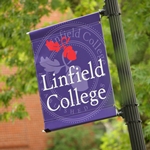 Upcoming events at Linfield College for the month of November. Continue reading
Upcoming events at Linfield College for the month of November. Continue reading
Monthly Archives: October 2012
Recent alum contributes historical nursing exhibition
 A newly installed exhibit created by recent graduate Rosa Gimson ’12 captures the rich and significant history of Linfield’s School of Nursing. Continue reading
A newly installed exhibit created by recent graduate Rosa Gimson ’12 captures the rich and significant history of Linfield’s School of Nursing. Continue reading
Linfield Reports, 10/22/12
Enrollment up in Linfield College online program, nursing degrees favored
 This fall Linfield College experienced a 12 percent increase in enrollment in its online programs, and consistent with national trends, Linfield students favor health care degrees. Continue reading
This fall Linfield College experienced a 12 percent increase in enrollment in its online programs, and consistent with national trends, Linfield students favor health care degrees. Continue reading
Linfield students poised to make a difference during annual service event
 More than 150 members of the Linfield College community, including students, families, faculty and staff, will canvas Yamhill County on Saturday, Oct. 27, to volunteer their time, energy and talents during Make A Difference Day. Continue reading
More than 150 members of the Linfield College community, including students, families, faculty and staff, will canvas Yamhill County on Saturday, Oct. 27, to volunteer their time, energy and talents during Make A Difference Day. Continue reading
Linfield College archive memorializes regional wine history, says Portland Tribune
 The Portland Tribune and Forest Grove News-Times paid tribute to the Oregon Wine History Archive at Linfield College. Continue reading
The Portland Tribune and Forest Grove News-Times paid tribute to the Oregon Wine History Archive at Linfield College. Continue reading
Faculty recital to feature pianist
 The Linfield College Music Department will present a faculty recital featuring pianist Chris Engbretson Saturday, Oct. 27, at 3 p.m. in the Richard and Lucille Ice Auditorium in Melrose Hall at Linfield. Continue reading
The Linfield College Music Department will present a faculty recital featuring pianist Chris Engbretson Saturday, Oct. 27, at 3 p.m. in the Richard and Lucille Ice Auditorium in Melrose Hall at Linfield. Continue reading
Oregon Wine History Archive at Linfield College brings history of regional pinot noir to the web
 Reprinted from the Portland Tribune and the Forest Grove News-Times, story by Christian Gaston
Reprinted from the Portland Tribune and the Forest Grove News-Times, story by Christian Gaston
In the spring of 2011, Jeff Peterson and Thomas Hellie met Oregon wine pioneer Dick Erath at Dundee Bistro to talk wine. Peterson, head of Linfield College’s newly established Center for the Northwest, brought Hellie, the college’s president, to pitch Erath on a new project: The Oregon Wine History Archive.
Peterson hoped to gather personal papers and recollections from people such as Erath, who built the Willamette Valley’s wine industry from whole cloth and created a new brand, Oregon Pinot Noir, that would bring the region international fame. The hope was to build an archive that would memorialize the industry’s birth and detail the lives of those early growers.
It wasn’t a hard sell. “Well, they say all politics is local,” Erath told Peterson and Hellie. “And I think history should be local. I can’t think of a better place than Linfield to have these papers.”
Since then, Linfield’s archives have grown to include a 1974 bottle of Erath’s pinot noir, one of the state’s earliest, roughly 80 linear feet of papers, maps and photographs detailing the work of Erath, David and Diana Lett, Myron Redford, David Adelsheim, Bill and Susan Sokol-Blosser, and Dick and Nancy Ponzi.
The archive is a perfect fit for Linfield College, located in McMinnville, just a short drive from pioneering pinot noir wineries in the fertile Willamette Valley.
Peterson said that core of early Oregon pinot growers has contributed heavily to the archive, which he hopes will continue to tell their stories long after the first wave of pinot pioneers pass on. “Dick has been very kind, as has been Susan Sokol-Blosser and the Ponzis,” Peterson said. “They actually spend time with our students.”
The archive is maintained in a 65-degree atmosphere (about 10 degrees warmer than a wine cellar) and tended by full-time archivist Rachael Woody and a rotating cast of student archivists who gather material from donors, then sort and digitize it. Not all the material can be digitized, but what does make it to the computer winds up online at Linfield’s Digital Commons, opening the virtual doors of the archive to the world.
“It brings alive unique items that are normally not available to the public unless they come to the archives,” said Linfield Library Director Susan Barnes Whyte. “People can do a Google search on Oregon wines and come across these archives.”
The story of Oregon pinot noir begins in an unlikely place, the University of California, Davis. It was there that a handful of renegade winemakers developed the idea of growing pinot noir and other grape varieties in places like Oregon. Far to the north of sunny California, the climate and soils of the Willamette Valley should mimic the conditions of central Europe. Or so the theory went.
In 1965, David Lett brought thousands of wine cuttings to Oregon and planted his first grapes in the hills of Dundee. The same year, Charles Coury, another UC Davis student planted a variety of grapes − including pinot noir − on David Hill, near Forest Grove. Erath, another UC Davis grad, made his first barrel of wine in his garage that year. Coury’s wines never made a big splash. But by 1975, Lett’s pinot noir was wowing critics and battling with French wines grown from comparatively ancient stock.
Lett’s Eyrie Vineyards was joined by Erath’s vineyard in 1968, Myron Redford’s Amity Vineyards in 1970, Sokol-Blosser wines in 1970, Ponzi Vineyards in 1970 and Adelsheim Vineyard in 1971. The archives at Linfield College tell a story of a close-knit community of winemakers who relied on each other, and a bit of luck, to build their family businesses into wineries with international prestige.
In 2008, the Oregon wine community was rocked by news of Lett’s death. And since then a number of the early pioneers have passed the day-to-day operation of their wineries on to their children. That generational churn is underlining the importance of the Linfield archive’s work in gathering papers and conducting interviews with the surviving pinot innovators.
“We’re doing something that is going to help the industry because you want to preserve these documents,” Peterson said.
The archive also provides a place for students such as sophomore Terran Sobel-Smith to polish their archivist chops and learn more about the history of the region. Sobel-Smith spent the summer at the archive full time and expects he’ll stick around during the rest of his tenure at Linfield.
This coming year, the archive will be able to fund even more student internships, thanks to an $8,000 grant from the Oregon Cultural Trust. The grant also will fund the nuts and bolts of running an archive − cotton gloves, acid-free paper and boxes. For Sobel-Smith, shivering in the cold, dry archive is worth it when he thinks about the change that the people he’s documenting have made in Oregon and the world.
“They have created this facet of Oregon history and it’s created a new name for Oregon and I think that’s phenomenal,” Sobel-Smith said. “I think everyone should know at least something about that.”
Strive to archive (News-Register)
Linfield Reports, 10/15/12
Fierce competition led to NW salmon industry decline, says Linfield prof in a new book
 The arbitrary U.S.-Canadian political border contributed to international tensions and led to a fierce competition that almost decimated the salmon industry, says history Professor Lissa Wadewitz in a new book. Continue reading
The arbitrary U.S.-Canadian political border contributed to international tensions and led to a fierce competition that almost decimated the salmon industry, says history Professor Lissa Wadewitz in a new book. Continue reading

